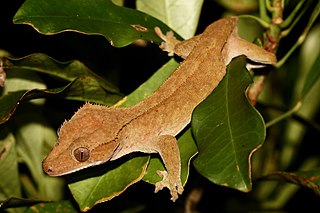
Geckos are small, mostly carnivorous lizards that have a wide distribution, found on every continent except Antarctica. Belonging to the infraorder Gekkota, geckos are found in warm climates throughout the world. They range from 1.6 to 60 centimetres.

Gekkonidae is the largest family of geckos, containing over 950 described species in 64 genera. Members of the Gekkonidae comprise many of the most widespread gecko species, including house geckos (Hemidactylus), tokay geckos (Gekko), day geckos (Phelsuma), mourning geckos (Lepidodactylus) and dtellas (Gehyra). Gekkonid geckos occur globally and are particularly species-rich in tropical areas.

Gekko is a genus of Southeast Asian geckos, commonly known as true geckos or calling geckos, in the family Gekkonidae. Although species such as Gekko gecko are very widespread and common, some species in the same genus have a very small range and are considered rare or endangered.
Cnemaspis is a genus of diurnal (day) geckos found in Asia. With over 100 species, it is one of the most diverse genera of geckos. Molecular phylogenies suggest that the two regional groupings may form distinct clades which are not each other's closest relatives.

Cyrtodactylus is a diverse genus of Asian geckos, commonly known as bent-toed geckos, bow-fingered geckos, and forest geckos. The genus has about 300 described species as of 2020, which makes it the largest of all gecko genera.

Bavayia is a genus of lizards in the family Diplodactylidae. Species in the genus Bavayia are also known commonly as New Caledonian geckos or bavayias. The genus is native to the remote New Caledonia and Loyalty Islands. The 12 species are moderately small to medium-sized geckos, and are distinguished from other genera by their tail length and the shape of their digits.

The crested gecko or eyelash gecko is a species of gecko native to southern New Caledonia. In 1866, the crested gecko was described by a French zoologist named Alphonse Guichenot. This species was thought extinct until it was rediscovered in 1994 during an expedition led by Robert Seipp. Along with several other New Caledonian gecko species, it is being considered for protected status by the Convention on the International Trade in Endangered Species of Wild Flora and Fauna.

The leopard gecko or common leopard gecko is a ground-dwelling lizard native to the rocky dry grassland and desert regions of Afghanistan, Iran, Pakistan, India, and Nepal. The leopard gecko has become a popular pet, and due to extensive captive breeding it is sometimes referred to as the first domesticated species of lizard.

The Diplodactylidae are a family in the suborder Gekkota (geckos), with over 150 species in 25 genera. These geckos occur in Australia, New Zealand, and New Caledonia. Diplodactylids are the most ecologically diverse and widespread family of geckos in both Australia and New Caledonia, and are the only family of geckos found in New Zealand. Three diplodactylid genera have recently been split into multiple new genera.

Anthony Hume Whitaker was a New Zealand herpetologist, contributing a 50-year career of fieldwork, pioneering research and species discoveries. His is still the largest collection of reptile and amphibian specimens donated to Museum of New Zealand Te Papa Tongarewa.
New Caledonian gecko may refer to any of the below, both genera placed in the Diplodactylidae family, and found in New Caledonia:

Dierogekko is a genus of geckos in the family Diplodactylidae. The genus is endemic to the northwest portion of New Caledonia. They are sometimes known commonly as the striped geckos or the New Caledonian geckos. Dierogekko are small geckos with simple, granular scales and subdued patterning of broad longitudinal stripes or spots. They are similar in overall appearance and habit to closely related geckos in the genera Bavayia and Oedodera, and the type species D. validiclavis was once referred to Bavayia.
Dierogekko validiclavis, also known as the bold-striped gecko, is a gecko endemic to Grande Terre in New Caledonia.
Dierogekko inexpectatus also known as Key New Caledonian Gecko is a gecko endemic to Grande Terre in New Caledonia.
Dierogekko insularis, also known as the Islands striped gecko, is a gecko endemic to Grande Terre in New Caledonia.
Dierogekko koniambo, also known as the Koniambo striped gecko, is a gecko endemic to Grande Terre in New Caledonia.
Dierogekko poumensis, also known as the Poum striped gecko, is a gecko endemic to Grande Terre in New Caledonia.
Dierogekko thomaswhitei, also known commonly as White's nimble gecko and the Taom striped gecko, is a species of lizard in the family Diplodactylidae. The species is endemic to New Caledonia.
Dierogekko baaba also known as Grande Terre striped gecko, is a gecko endemic to Grande Terre in New Caledonia.











